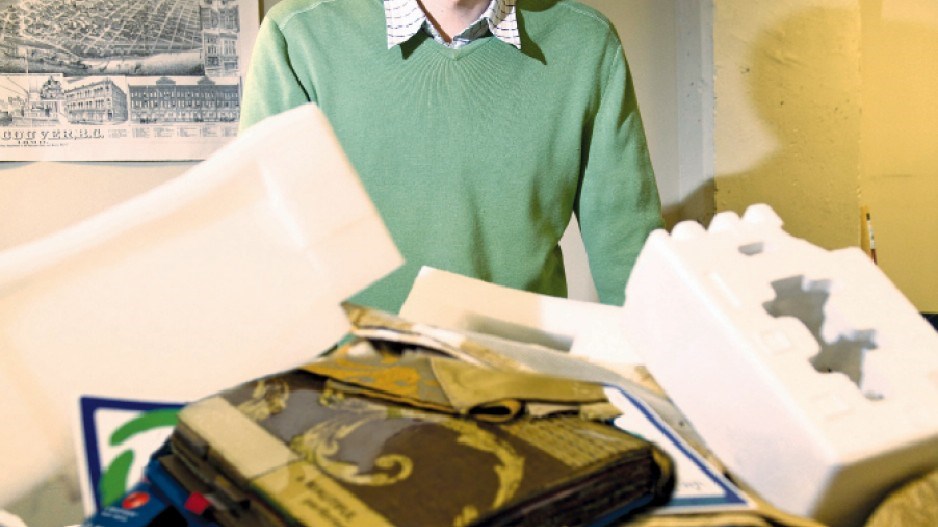While the three Rs of waste management – reduce, reuse, recycle – roll off the tongue easily, what’s not as straightforward is how to accomplish them.
It may be hard, if not impossible, to look at your company’s waste stream, for example, and see any value in it. But in the past few years, organizations around the Lower Mainland have been develop-ing programs to do just that – create value out of waste, as well as aide in the reduction of overall carbon footprints.
In Vancouver’s Strathcona area, the Strathcona Business Improvement Association (BIA) has been branding itself as a green hub in an urban core. The BIA helps connect businesses with one another so that one company’s waste can be another’s source of income.
“All these things landing in the landfill can be valuable to others,” said Joji Kumagai, executive director of the Strathcona BIA.
In a recent example, a local fabric distribution business had hundreds of old sample books they were going to throw out. The pieces of material seemed too small to be of any use, but a creative artist took the samples and transformed them into wallets and handbags to sell.
In another example, the BIA linked a printing company with another business that produces corporate gift boxes. Rather than use Styrofoam peanuts or other packing material for their gifts, the business now uses paper off-cuts from the printing company.
“The big challenges is relationship building – talking to businesses about what sustainability is,” said Kumagai. “It can be daunting. Everyone knows there’s something that should be done in the community. Some are ahead of the curve, others trying to find their way.
“For the most part, when people find out it’s a chance to reduce their footprint and to improve efficiency of the supply chain or reduce waste or repurpose items for peope who are doing good things – they’re keen.”
The Strathcona BIA is in the midst of building a type of Craigslist for waste sharing. Those with items to give away can list them in a special section of the BIA’s site, as can those looking for unique materials.
A glance shows people looking for tree branches that have recently been cut down, computer printers and monitors, and used, clean packing peanuts.
At Vancouver’s Fairware, co-founder Denise Taschereau changes client behaviour through promotional products.
“We help companies align promotional products and marketing incentives with their sustainability values,” said Taschereau. Fairware provides promotional solutions for companies that want to maintain sustainability throughout their brand, but it also works with clients to take advantage of their own waste stream to build new products. For example, working with Aspen Ski Resort, Fairware took their old ski uniforms that were out of date and made them into tote bags and toiletry kits.
“We’re starting to see companies come to us to try and make products out of waste,” said Taschereau, who added that Fairware is now creating padfolios out of old banners from the 2010 Games that RBC will use for London Games this summer.
Recently named one of the top-10 fastest-growing promotional product distributors in Western Canada, Fairware is more than just a product provider, Taschereau points out. It works with a company’s whole marketing plan.
“We look at the brand roll out, marketing strategies, the coming quarter and the coming year, and we talk about what they want to achieve and how the products tell that story,” she explained.
“Our core client base has a deep commitment to social responsibility. We are not sitting in offices of companies that are early on in this strategy. We work with Patagonia, Aveda, Vancity – companies that are quite evolved. We’re part of the strategic conversation: How do we align the product with the values?”
That commitment to social responsibility starts with a strong culture, said Michael Driedger, sustainability building adviser for architecture design firm Perkins+Will.
“It’s everyone embracing a philosophy of good design – which is sustainable design – and social responsibility, which goes hand in hand with environmental responsibility. We engage staff on multiple levels from transit and fitness subsidies to donating our consulting time to local projects in Vancouver that could benefit from our services but can’t afford them.”
Recently, Perkins+Will has focused a lot of effort on changing behaviour around air travel.
“As for operational and staff engagement it is creating a culture of people who will use communication technology over transportation technology,” Driedger explained. “Given the efficiency and importance of face-to-face interactions, getting people to use teleconference equipment will continue to be a challenge. Changing habits like these, as well as consumptions habits, is always challenging. Getting people to use less and educate themselves more is never an easy task in a society with attractive products and information overload.” •




